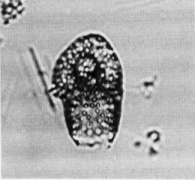 Centrobotrys
petrushevskayae Sanfilippo and Riedel
Centrobotrys
petrushevskayae Sanfilippo and Riedel Centrobotrys
petrushevskayae Sanfilippo and Riedel
Centrobotrys
petrushevskayae Sanfilippo and RiedelCentrobotrys(?) sp. A Riedel and Sanfilippo, 1971, p.1602, pl.3F, figs.15-16
Centrobotrys petrushevskayae Sanfilippo and Riedel, 1973, p.532, pl.36, figs.12-13
Prominent eucephalic lobe surrounded by a large, irregularly pored chamber that is not subdivided into ante- and post-cephalic parts. Cephalic outline generally smoothly rounded, but in late forms its apex tends to be pointed though to a lesser degree than in C. thermophila. Thorax subcylindrical, its wall irregularly porous, tending to be closed distally in some late specimens (Sanfilippo and Riedel, 1973).
Based on 20 specimens. Maximum breadth of cephalis 45-65 mm (Sanfilippo and Riedel, 1973).
This species differs from Centrobotrys thermophila in having a more porous shell and rounded apex, and from C. gravida in not having the thorax closed and inflated, and in somewhat thinner shell wall. C. petrushevskayae appears to represent an evolutionary link between C. gravida and C. thermophila (Sanfilippo and Riedel, 1973).
The merged ante- and post-cephalic chambers, which surround the eucephalic chamber, have an outline that usually comes to a rounded point apically, though in some specimens it is semicircular or (rarely) multi-lobed. Subcircular pores of unequal sizes are almost uniformly distributed over the shell wall. The subcylindrical thorax is of the same size as the cephalis, or smaller, and is rarely closed terminally (Sanfilippo et al., 1985).
This species occurs in small numbers, but is found in low-latitude assemblages of middle Oligocene age in all major ocean basins. It evolves within the Theocyrtis tuberosa Zone and its evolution to Centrobotrys thermophila is approximately synchronous with the lower limit of the Dorcadospyris ateuchus Zone.
C. petrushevskayae is the intermediate form in the lineage from C. gravida to C. thermophila.